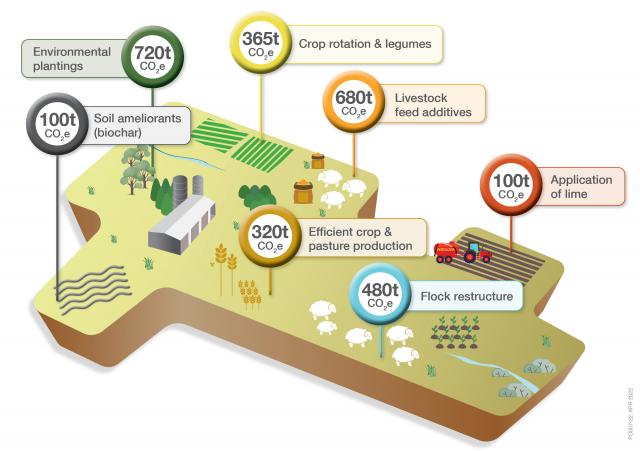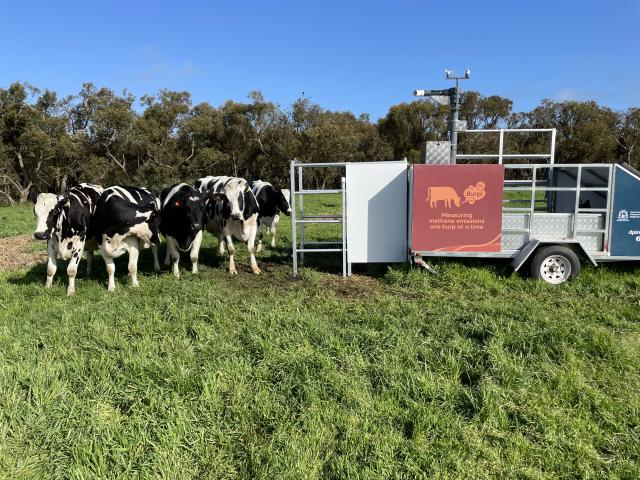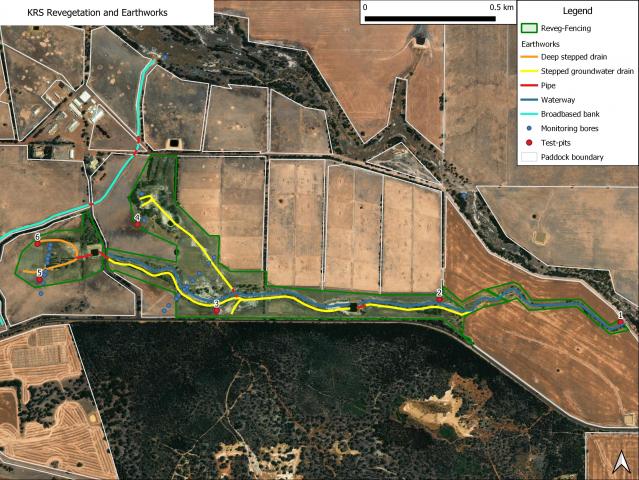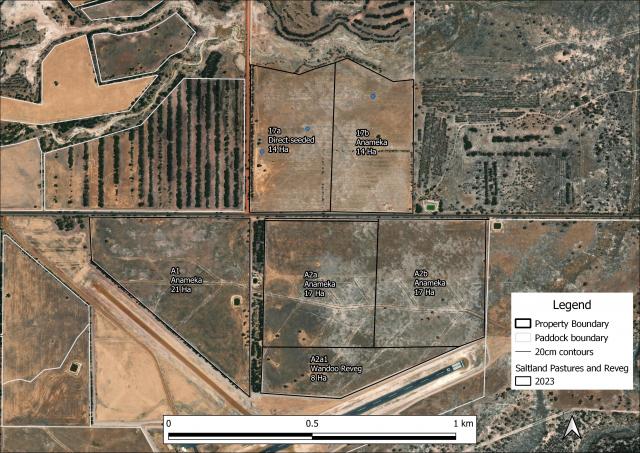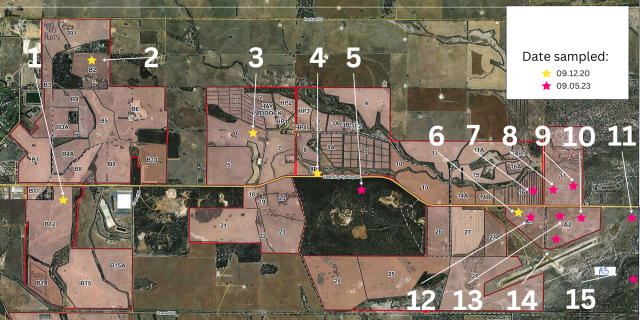DPIRD identified the Katanning Research Station (KRS) as a significant greenhouse gas (GHG) emitter, offering the opportunity to better understand the emissions arising from agriculture, and particularly livestock production. This demonstration project contributes to the West Australian Government’s commitment to emissions reduction and the sustainable mitigation of climate change.
DPIRD developed a strategy focussed on practical techniques and methods for mitigating greenhouse gas emissions from the livestock industry in Western Australia (WA). The strategy has two specific aims:
- To lower net emissions from DPIRD’s Katanning Research Station and achieve carbon neutrality on-farm by 2030, and
- Utilise the Katanning Research Station as a practical demonstration site to provide and support the application of tested carbon-neutral options for Western Australian broadacre farmers.
The baseline emissions and reduction plan for KRS was devised in 2020. The methodology, opportunities and progress of work undertaken from 2020-2023 can be found on the next page.
Planned works 2024-2026
Research, development and adoption (RD&A) for emissions mitigation, both on the station and in broadacre agriculture activities will be the focus over the next couple of years. The following works are in the design stage planned for 2024-2026
- Enteric methane research
- Revegetation and Agroforestry
- Implementing the Energy Audit recommendation
Livestock methane research
Ruminant livestock emit significant amounts of methane. DPIRD has undertaken a significant investment in the purchase of five GreenFeed machines to measure sheep and cattle methane emissions in the paddock. This technology enables researchers to explore emissions related to different feed types such as Lupins, Biserrula, and Saltbush.. The GreenFeed technology, developed by C-Lock in the United States of America, serves as an in-paddock measurement tool for ruminant animals.
Trials commencing in early 2024:
• Comparing GreenFeed methane data with methane data from Portable Accumulation Chambers (PAC) at the Katanning Research StationU
• Annual methane profile of sheep in southern agricultural systems at the Katanning Research Station – sheep grazing winter annual pastures, high legume spring pastures, cereal stubble, autumn pastures with grain supplementation
Initially, all four sheep machines will be at the Katanning Research Station, with future projects in the design phase. The availability of four machines enables concurrent trials, including the baseline sheep emissions measurement for a standard sheep system. We are further designing trials to compare emissions related to different feed types such as Lupins, Biserrula, and Saltbush in order to understand the unique feed systems used in WA.
Revegetation and Agroforestry
Over the upcoming years, there are plans to introduce a variety of trees and shrubs to both the marginal and some arable sections of the farm. In August 2023, the team conducted a farm audit, pinpointing potentially suitable locations for agroforestry, habitat creation, and infill areas. This audit revealed the potential for up to 195 hectares of new plantings.
Collaborating with consultants and industry experts, we will carefully choose species well-suited to the various soil types and intended purposes. Currently, our focus centres on protecting and enhancing existing vegetation, planting areas that are non-arable or not suitable for grazing or cropping, enhancing shade and shelter, and protecting areas at risk of salinity. the opportunities around plantings that support a woody biomass for renewable energy industries.
Energy Audit Recommendations
The overall energy usage across the entire DPIRD Katanning Research Centre is relatively low and represents a small part of the operating cost and carbon account. There are some simple opportunities to reduce emissions and costs.
DPIRD has the opportunity to invest $132k into energy efficiency and solar supply onsite, reducing the energy costs from $24k to $0 p/a.
The financial benefit accrues annually for the life of the project, in this case, 25 years, accumulating $590,000 of avoided energy costs for an establishment cost of $132,000.
Energy efficiencies focus on:
- Lighting - Replace old inefficient lighting across all buildings.
- Heating and cooling - Insulate site, including all external mechanical plant and pipes.
Energy supply opportunities:
Installation of rooftop solar arrays, designed to match baseline power usage will cost $118,500 for 72.5 kW with a cost reduction of $18,450 per annum, with a payback period of seven years.
KRS baseline emissions and reduction plan
In 2020, DPIRD Livestock and Farming Systems staff worked with Dr. Stephen Wiedemann of Integrity Ag to undertake a baseline organisational carbon footprint assessment and an emissions reduction strategy to achieve carbon neutrality for the research station by 2030. The Katanning Research Facility Carbon Footprint Assessment and Strategy to Achieve Carbon Neutrality by 2030 full report provides information on:
- the methodogy,
- total emissions,
- product intensity,
- opportunities for reducing emissions and
- scenario modelling of cropping, livestock, soil carbon and pastures and overview of vegetation and vegetation carbon.
The report offers insights for producers and industry as it provides a benchmark on many of the enterprise inputs and outputs while exploring mitigation options for KRS.
Progress of emission reduction strategies
The total emissions for the KRS farm were 2406 and 2553t CO2-e for 2018 and 2019, respectively, excluding soil and vegetation carbon change. This provided a baseline for the KRS of 2480t CO2-e . Most emissions arose from the sheep flock, with lower contributions from cropping
The KRS research team identified a range of options for reducing emissions and have been pursuing the following strategies to reduce emissions:
- Rehabilitation and revegetation of non-arable land.
- Shoring up water supply.
- Understanding Soil carbon and soil quality.
- Carbon-based soil amelioration demonstration
- Restructuring the sheep flock.
Rehabilitation and revegetation of non-arable land:
The overarching aim of this aspect of the project was to contribute to emission reduction through comprehensive rehabilitation and revegetation efforts on non-arable land. Salt land rehabilitation provides an opportunity to increase carbon storage through sustainable land management practices and revegetation would increase fodder supply over autumn. By increasing feed for sheep, the need to purchase feed is reduced consequently reducing emissions required for transporting feed.
Two key areas were targeted: the main drainage line at the front and a low-lying area on the eastern side of KRS.
Integrated salinity rehabilitation
A 24-hectare degraded zone along Nyabing Road underwent rehabilitation with the construction of a groundwater drain, completed in July 2023. The revegetation involved using over 50 local plant species to enhance biodiversity and create a thriving ecosystem that supports both native flora and fauna, showcasing best-practice land management for farmers..
The drainage works include broadbased banks and groundwater drains to dry out the surface water profile and baseflow groundwater, thereby allowing soil surface cover and effective revegetation. .
The groundwater drain component was completed in July 2023, and two videos have been produced. The first video outlines the essential planning requirements for construction. The second video outlines the groundwater construction techniques and how these were adapted to the natural features of the site.
Low-lying pasture land
Approximately 85 hectares of marginal saline land were planted with a saltbush system, contributing to both emission reduction and enhanced land productivity (LINK to new page). This system consists of predominantly 10 m spaced double rows of Anameka saltbush with a perennial interrow of tall wheatgrass, Puccinellia and Kikuyu. This will substantially increase the productivity of the land by providing forage options during the autumn feed gap.
Understanding soil carbon and soil quality
Ongoing research at the station focuses on enhancing soil organic content, which offers the dual benefit of sequestering carbon and improving overall productivity. A program of soil carbon measurement is underway to investigate and document the impact of land use on soil organic carbon. The map below identifies the soil sampling locations.
Shoring up water supply
DPIRD is investigating the opportunity for a more sustainable water supply for the feedlot and cropping requirements of Katanning Research Station. In May 2023, a production bore test hole yielded a flow rate of two litres per second. The water quality of the bore is approximately 870 millisiemens per meter (mS/m), indicating some salinity.
Two potential approaches are under consideration to address the salinity. Either, dilute the saline groundwater with dam water, effectively reducing the salinity levels, or construct a reverse osmosis plant. Both approaches would help ensure a reliable water supply for animals while improving saline areas.
Carbon-based soil amelioration demonstration
A demonstration trial installed in the low-lying pasture land was established to assess the viability of carbon-based amelioration products. The project aims to compare the impact of compost, granulated compost, and biochar on plant growth, soil health, and soil carbon.
The objectives of the demonstration are:
- To compare granulated compost with loose compost at equivalent nitrogen application rates for biomass growth and economic viability, focusing on using standard agricultural equipment.
- Compare the following treatments of Biochar, mineral fertiliser, compost alone, and compost and mineral fertilisers combined. The compost/mineral blend will assess the impact of substituting one-third of synthetic nitrogen with organic nitrogen (33% organic N: 67% mineral N) for both loose and granulated organic products.
- To evaluate the changes in soil organic matter resulting from organic amendments.
The experiment has nine treatments, including control, fertilisers, granulated compost, loose compost, biochar, and combinations of these, focusing on matching nitrogen levels across treatments. Pasture assessments and soil analyses will evaluate the impact of these organic amendments.
The goal is to provide practical and affordable solutions for enhancing soil organic carbon levels and promoting sustainable agriculture practices while working towards carbon neutrality and maintaining profitability. The experiment began on August 23, 2023, and will continue until 2026.
Restructuring the sheep flock
KRS management have reduced the replacement flock size by purchasing required adult ewes instead of raising replacement ewes from lambs. The total sheep numbers are 10% lower in 2023 than in 2019, resulting in an estimated emissions reduction of approximately 10% per annum. Further work and modelling is focused on analysing the impacts of increasing lambing rate, lamb turn off date and weight on total emissions and emissions intensity.
Contact:
Justin Hardy
Carbon neutral R&D lead and demonstration at Katanning Research Station
Phone: +61 (0)8 9892 8408
Email: Justin.Hardy@dpird.wa.gov.au
Gus Manatsa
Emissions Lead, Climate Resilience Program
Phone: +61 473 615 409
Email: Gus.Matasa@dpird.wa.gov.au

